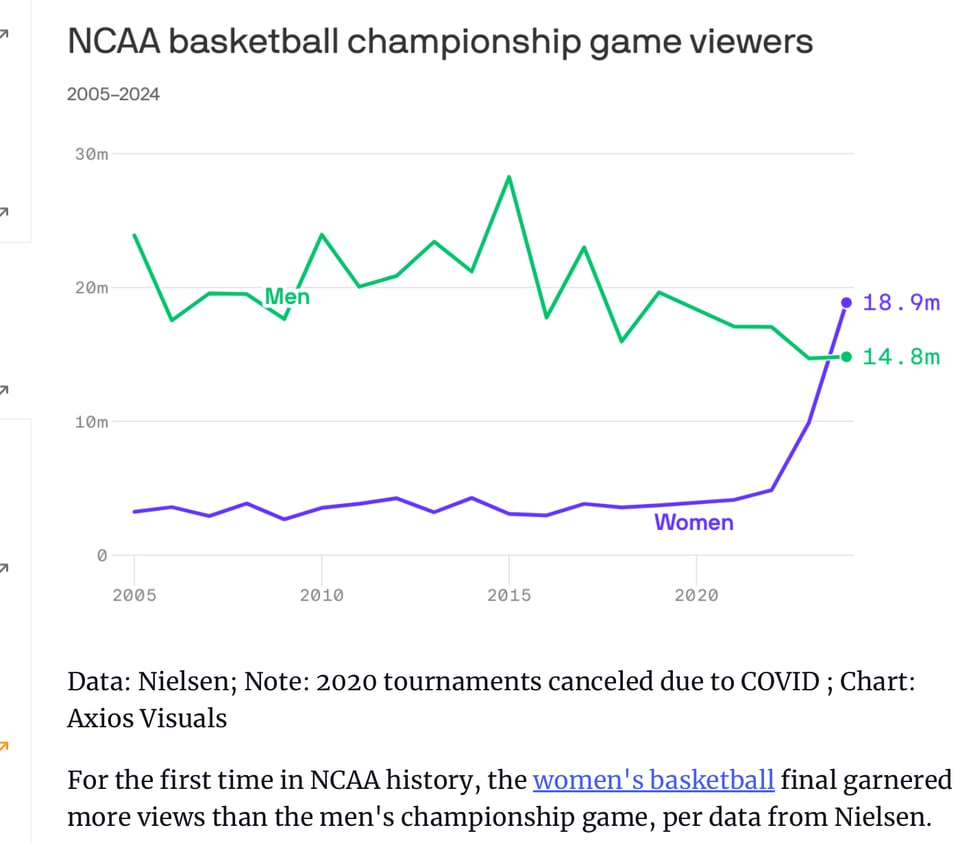Thursday, April 11,2024. Annette’s News Roundup.
I think the Roundup makes people feel not so alone.
To read an article excerpted in this Roundup, click on its blue title. Each “blue” article is hyperlinked so you can read the whole article.
Please feel free to share. Invite at least one other person to subscribe today! https://buttondown.email/AnnettesNewsRoundup
Sharing information will help us win in 2024.
____________________________________________
Joe is always busy.
WATCH: Biden and Japanese Prime Minister Kishida hold joint news conference.
“Ukraine today, maybe East Asia tomorrow”, says Japanese PM Kishida - this is exactly the view I heard from leaders from the U.S. to Europe to Asia, drawing a direct line between Russia’s invasion of Ukraine and China’s designs on Taiwan.
— Jim Sciutto (@jimsciutto) April 10, 2024
It’s a big deal. pic.twitter.com/gtGFfNVCgN
— Joe Biden (@JoeBiden) April 9, 2024
HUGE: @POTUS is announcing his plan to expand on his administration's work to advance care for hardworking families across the nation — including investing in child care, paid family and medical leave, tax cuts for workers and more! #TheCareEconomy https://t.co/Jq93718Lkf
— Building Back Together (@BuildingBack_US) April 9, 2024
FACT SHEET: Biden-Harris Administration Highlights Substantial Progress on the President’s Care Agenda During Month of Action on Care | The White House.
Donald Trump is worried that since he's responsible for overturning Roe, the voters will hold him accountable in 2024.
— Joe Biden (@JoeBiden) April 8, 2024
I have news for Donald: They will. pic.twitter.com/kiwfzwjxxY
The White House will honor “Rosie the Riveters,” women who joined the workforce during World War II, with a Congressional Gold Medal Ceremony on Wednesday. https://t.co/TKXZCQdSWt
— PBS NewsHour (@NewsHour) April 10, 2024
Touch 👇 to watch the new Biden ad.
BREAKING: The Biden campaign just released this powerful ad highlighting President Biden’s vision for America. Retweet to make sure all Americans see. pic.twitter.com/8RDtUG5AUH
— Biden’s Wins (@BidensWins) March 8, 2024
____________________________________________
Kamala is always busy.
During Find Your Place in Space Week, we celebrate @NASA Astronaut Christina Koch and the entire Artemis II crew for inspiring the next generation of astronauts. Together, you are opening doors for new leaders to find their place in space. pic.twitter.com/cL05aHQZOK
— Vice President Kamala Harris (@VP) April 10, 2024

This HBCU team from Tennessee A&I won the men’s national basketball championship 3 times and never were honored at the White House. That ended here.
The Tennessee A&I Tigers men's basketball team won a historic national championship in 1957.
— Vice President Kamala Harris (@VP) April 8, 2024
And 1958.
And 1959.
Now, 65 years later, it was my honor to welcome them to the White House to celebrate their excellence on and off the court. pic.twitter.com/6fbHetcjL1
____________________________________________
Random photographs from the White House State Dinner for Japanese Prime Minister Kishida.



____________________________________________
The Biden-Harris Administration makes your water safe.
E.P.A. Says ‘Forever Chemicals’ Must Be Removed From Tap Water.
The rule applies to a family of chemicals known as PFAS that are linked to serious health effects. Water utilities argue the cost is too great.

For the first time, the Biden administration is requiring municipal water systems to remove six synthetic chemicals linked to cancer and other health problems that are present in the tap water of hundreds of millions of Americans.
The extraordinary move from the Environmental Protection Agency mandates that water providers reduce perfluoroalkyl and polyfluoroalkyl substances, known collectively as PFAS, to near-zero levels. The compounds, found in everything from dental floss to firefighting foams to children’s toys, are called “forever chemicals” because they never fully degrade and can accumulate in the body and the environment.
The chemicals are so ubiquitous that they can be found in the blood of almost every person in the United States. A 2023 government study of private wells and public water systems detected PFAS chemicals in nearly half the tap water in the country.
Exposure to PFAS has been associated with metabolic disorders, decreased fertility in women, developmental delays in children and increased risk of some prostate, kidney and testicular cancers, according to the E.P.A.
Michael S. Regan, the E.P.A. administrator, called the new regulation “life changing.”
“This action will prevent thousands of deaths and reduce tens of thousands of serious illnesses,” Mr. Regan said on a call with reporters on Tuesday. He described the rule as the most significant action the federal government has ever taken to reduce PFAS exposure in drinking water.
“We are one huge step closer to finally shutting off the tap on forever chemicals once and for all,” he said.
The E.P.A. estimated it would cost water utilities about $1.5 billion annually to comply with the rule, though utilities maintain that the costs could be twice that amount and are worried about how to fund it. States and local governments have successfully sued some manufacturers of PFAS for contaminating drinking water supplies, but the settlements awarded to municipalities have been dwarfed by the costs of cleaning up the chemicals, municipal officials said.
Industry executives say taxpayers will ultimately foot the bill in the form of increased water rates.
The 2021 bipartisan infrastructure law provides $9 billion to help communities address PFAS contamination and the E.P.A. said $1 billion of that money would be set aside to help states with initial testing and treatment.
Mr. Regan is expected to formally announce the regulation on Wednesday in Fayetteville, N.C., near the site where, in 2017, a Chemours chemical plant discharged water contaminated with PFAS into the Cape Fear River, making the local drinking water unsafe.
Mr. Regan, who previously served as North Carolina’s top environmental regulator, oversaw the Cape Fear PFAS investigation at the time and forced Chemours to clean up the air, soil and water in the lower Cape Fear River basin communities.
In 2022, the E.P.A. found the chemicals could cause harm at levels “much lower than previously understood” and that almost no level of exposure was safe.
Under the new rule from the E.P.A., water utilities must monitor supplies for PFAS chemicals and would be required to notify the public and reduce contamination if levels exceeded the new standard of 4 parts per trillion for perfluoroalkyl and polyfluoroalkyl substances. Previously, the agency had advised that drinking water contain no more than 70 parts per trillion of the chemicals.
Public water systems have three years to complete their monitoring. If those samples show that levels of PFAS exceed the new E.P.A. standards, the utilities would have another two years to purchase and install equipment designed to filter out PFAS.
In a 2020 peer-reviewed study, scientists at the Environmental Working Group, a nonprofit organization, estimated that more than 200 million Americans had PFAS in their drinking water.
Public health advocates and scientists said the new regulation was overdue.
“A growing body of scientific research shows that PFAS chemicals are more harmful to human health than previously thought, and at extremely low levels,” said Anna Reade, director of PFAS advocacy at the Natural Resources Defense Council, an environmental group.
In just the past year, more than a dozen peer-reviewed studies have found evidence of additional health effects of PFAS exposure, including a delay in the onset of puberty in girls, leading to a higher incidence of breast cancer, renal disease, and thyroid disease; a decrease in bone density in teenagers, potentially leading to osteoporosis; and an increased risk of Type 2 diabetes in women.
Dr. Susan M. Pinney, the director of the Center for Environmental Genetics at the University of Cincinnati, led a longitudinal study of young girls who had been exposed to PFAS after an industrial plant in West Virginia released the chemicals into the Ohio River.
She called the number of people exposed to PFAS around the country “mind boggling.”
Robert A. Bilott, an attorney who has spent more than two decades litigating the hazardous dumping of PFAS chemicals, said he had alerted the E.P.A. to the dangerous posed by the chemicals in drinking water as early as 2001. “It has taken far too long to get to this point, but the scientific facts and truth about the health threat posed by these man-made poisons have finally prevailed,” Mr. Bilott said.
The E.P.A. calculated the health benefits of the new regulation at about $1.5 billion annually from reductions in cancer, heart attacks and strokes and birth complications.
But Republicans and industry groups, along with many mayors and county executives, said the Biden administration had created an impossible standard that would cost municipal water agencies billions of dollars.
Several questioned E.P.A.’s accounting as well as the science used to develop the new standard.
The American Water Works Association, the Association of Metropolitan Water Agencies and other groups representing water utilities estimated that the cost of monitoring and remediation of PFAS could be as much as $3.2 billion annually. The figure is based on an analysis conducted for the American Water Works Association by Black & Veatch, a firm of consulting engineers.
Communities with limited resources will be hardest hit by the new rule, they said.
“When regulations are set near zero, that is not something manufacturers or water systems can economically achieve,” Brandon Farris, the vice president of energy policy at the National Association of Manufacturers, wrote in a letter to the E.P.A. “Regulations that are not economically achievable will lead to critical substances being manufactured outside of the U.S. where environmental protections are often less stringent.”
Christina Muryn, the mayor of Findlay, Ohio, a town of about 50,000 people, said that, while clean drinking water is an imperative, the E.P.A. was requiring municipalities to meet new mandates without adequate support.
“That is very frustrating to me as a citizen, as a mayor, and as someone who is responsible for our water treatment system,” Ms. Muryn said.
Public health advocates said the costs of the new rule were outweighed by the growing body of evidence of the dangers posed by PFAS.
Widely used since the 1940s, the chemicals are useful in repelling water and oil. Nonstick pans have been most famously associated with PFAS but the chemicals can be found in water-repellent clothes and carpets, certain shampoos, cosmetics and hundreds of other household items. (New York Times).
How to get PFAs out of your home drinking water.
At least 45 percent of the nation’s tap water is estimated to have some type of PFAS, according to a new study by the United States Geological Survey. That means nearly half of us might be consuming PFAS through our drinking water every day.
Click the link above 👆 to find out whether dangerous ‘forever chemicals' are in your water, and if they are, which filters can remove them.
PFAS are chemicals found in our water, soil, air, and food.
— President Biden (@POTUS) April 10, 2024
They're dangerous, and my Administration is addressing them.
The @EPA is issuing the first-ever national standard to address PFAS and delivering $1 billion from my agenda to help states detect and treat this pollutant.
____________________________________________
Is Arizona a harbinger of the future?
Arizona’s abortion ban is back. It’s every state’s future if Trump wins.

Protestors in favor of abortion rights at the Tucson Federal Courthouse in Arizona on July 4, 2022.
On Tuesday, the Arizona Supreme Court ruled that its total abortion ban, a seemingly dead law dating back to 1864, is once again enforceable, despite more recent legislation that seemed to supercede it. The zombie ban makes virtually all abortions a felony, imposing a prison sentence of two to five years for any provider. There is no exception for rape or incest. The law was enacted before women could vote, and was long presumed to be permanently unenforceable. But the Arizona Supreme Court’s conservative majority, by a 4–2 margin, has now revived it. Republican governors appointed all seven justices on the bench, and the GOP recently expanded the court to entrench this far-right majority—which had no trouble finding that a ban enacted in an era in which women were chattel remains good law in 2024. As a result of this ruling, in 14 days almost every abortion in Arizona will be a crime, and nearly every clinic will close its doors. For all intents and purposes, it’s 1864 again for pregnant people in Arizona.
The decision should serve as a warning for the rest of the country, in light of ongoing efforts to revive the Comstock Act: In the hands of a far-right court, a dead, openly misogynistic, wildly unpopular abortion ban can spring back to life with a vengeance.
This zombie law was passed in 1864, long before Arizona was a state, and was codified in 1901, at which point it included a narrow exception to save the patient’s life. Much more recently, Arizona has passed less restrictive abortion laws, including a 15-week ban that appeared to wipe out more severe bans that preceded it. In late 2022, after the Supreme Court overturned Roe v. Wade, the Arizona Court of Appeals ruled that the two conflicting abortion laws in the state had to be reconciled, or “harmonized.” It maintained that abortion would remain legal through 15 weeks when provided by licensed physicians in compliance with the state’s other laws.
But on Tuesday, the Arizona Supreme Court, tasked with finally “harmonizing” Arizona’s 15-week abortion ban with the total ban dating back to hoop skirts, ruled that in the aftermath of Roe’s reversal in Dobbs, the total ban takes precedence: The more recent 15-week restriction, wrote the majority, “does not create a right to, or otherwise provide independent statutory authority for, an abortion that repeals or restricts” the 1864 law, “but rather is predicated entirely on the existence of a federal constitutional right to an abortion since disclaimed” by Dobbs. In other words, in “harmonizing” the two laws, the harsher one wins out—even though, as the dissenters noted, the Legislature seemed to override this absolute ban when passing the recent 15-week limit. And so, starting in two weeks, even rape victims at the earliest stage of pregnancy may not obtain a legal abortion in Arizona.
Since Dobbs, nearly two dozen states have banned or limited access to the procedure. Arizona now joins those states with almost no exceptions, according to the Guttmacher Institute. As was the case with the far-right Florida Supreme Court’s interpretation of that state’s constitution last week, the majority simply ignored any evidence that the original meaning and text of the recent law provided greater protections for reproductive freedom. Instead, the majority rejected the Legislature’s evident intent to supplant the Civil War–era law with a more lenient ban. As a consolation, it gestured toward the fact that Arizona voters will likely have an opportunity to enact a ballot initiative restoring reproductive rights. So Arizona now joins Florida as a state in which the high court takes away reproductive freedom with one hand while allowing it to go to a popular vote with the other. Abortion-rights groups say they have enough signatures to put the abortion amendment on the November ballot, creating a fundamental right to receive abortion care until viability. Unlike Florida, where amendments need 60 percent approval to pass, Arizona allows amendments to take effect with simple majority support. (Note, as well, that two justices in the majority on Tuesday have retention elections in November; if ousted, Democratic Gov. Katie Hobbs can replace them with progressives.)
In an election year in which winning the state of Arizona is an absolutely essential factor for the GOP, the abortion dog continues to catch the electoral car in ways that can only hurt Donald Trump and the GOP extremists who seek to harm women’s health and equality. So long as voters are aware of the game as it’s being played and what the stakes will be, Republicans faces the potential for heaving losses. So these efforts to do that which is extraordinarily unpopular must happen via subterfuge, wink-wink nudge-nudge public statements about states’ rights and not taking a national position on abortion, while the courts and would-be Trump administration functionaries do all the quiet dirty work. The self-evident tension between the massive public rebuke of Dobbs—in the form of state ballot initiatives and referenda, local special elections, and state Supreme Court races—and the unabating efforts by rogue legislatures and fringe Supreme Courts to roll back abortion rights, was in evidence withDonald Trump’s refusal to state a coherent position on abortion on Monday: Turning back the clock for women is a demonstrably losing issue at the ballot box. And when candidate Trump says he wants to return the issue of abortion to the states, what he is really saying is that Arizona is free to return the issue to the time before doctors understood the value of hand-washing. (Also, why would anyone take his word on anything, ever?)
What happened in Alabama in February, in Florida last week, and in Arizona on Tuesday makes it clear that returning the reproductive freedom landscape to the Victorian age requires subverting whatever happens in elections. That’s why this massive rollback will be achieved by antidemocratic measures, including promises to breathe new life into the Comstock Act, and revanchist theocratic decisions from courts attempting to do away with IVF and rape exceptions in the name of fetal and embryonic personhood.
Comstock, in particular, is an instructive comparison here. That 1873 law, read expansively, bans all abortions, including both medication and in-clinic procedures. Indeed, far-right lawyers are at the Supreme Court trying to weaponize it against abortion pills right now. Trump’s top lawyers, including Jonathan Mitchell, have said that they plan to use Comstock as a nationwide ban on abortion if Trump regains office. They tell us that they intend to stay quiet about this scheme until after the election, at which point they will prepare for an executive order accompanied by prosecutions and regulations that make abortion a federal felony in all 50 states. The plot is similar to what just happened in Arizona: Republicans enacted a seemingly moderate 15-week ban, only to stand by and watch as their colleagues on a GOP-packed court resuscitated a total ban passed during the Civil War. Democratic Attorney General Kris Mayes—who beat her anti-abortion opponent in 2022 by 280 votes—has said she won’t prosecute violations of the law. But GOP county attorneys have rejected Mayes’ efforts to shield doctors and may well seek to charge any providers that stay open, throwing access into immediate jeopardy.
The next time someone tells you they really worry about abortion rights, but that President Biden is just too old, please gently remind them that Joe Biden is not, in fact 160. That is the age of the law that will soon be sending abortion providers to prison in Arizona if they attempt to assist a victim of rape or incest. If edgy modernity is truly your thing, be afraid of Republican judges who are at war with modernity itself; they will gladly welcome the assistance of pro-choice voters whose apathy facilitates the rollback of women’s equal citizenship. And it’s now abundantly clear that we’re not rolling back the tape to the 1970s or to the 1920s. The project is to set your clocks back to the time when women didn’t even matter enough to have a vote. (Slate, BY DAHLIA LITHWICK AND MARK JOSEPH STERN)
___
Wondering who to vote against in Arizona in 2024?
Trump and Kari Lake, of course, and these jurists who clearly still live in 1864.
2 Arizona Supreme Court justices who banned abortion up for reelection.
The Arizona Supreme Court ruled the 1864 territorial ban on abortions can be enforced, with four justices voting in favor of the ban, two voting against and one not voting.
Two of the four justices who voted in favor of the ban are up for retention in November, meaning voters will decide whether or not to keep them on the court.
The court is made up of seven justices who are appointed by the governor and retained by voters two years after their initial appointment and every six years thereafter. The court's chief justice is selected by their colleagues and serves a term of five years.
Who is on the Arizona Supreme Court?
Chief Justice Robert M. Brutinel was appointed by Gov. Jan Brewer in 2010 and became chief justice in 2019.
Vice Chief Justice Ann A. Scott Timmer was appointed by Brewer in 2012 and became vice chief justice in 2019.
Associate Justice James P. Beene was appointed by Gov. Doug Ducey in 2019.
Associate Justice Clint Bolick was appointed by Ducey in 2016. He has no judicial experience and previously worked as the vice president of litigation for the Goldwater Institute and served on Ducey's transition team. Bolick is married to state Sen. Shawnna Bolick, R-Phoenix.
Associate Justice Kathryn H. King was appointed by Ducey in 2021. King previously served on the Arizona Board of Regents and as an aide in Ducey's administration.
Associate Justice John R. Lopez IV was appointed by Ducey in 2016 and was the first Hispanic justice to serve on the court.
Associate Justice William "Bill" G. Montgomery did not participate in the abortion case. He was appointed by Ducey in 2019 after serving as the Maricopa County attorney for nearly a decade. He was rejected from the shortlist for another vacancy that year due to questions about his impartiality on issues like sentencing reform, decriminalizing marijuana and LGBTQ+ rights.
How did the justices vote?
Justices John R. Lopez IV, Clint Bolick, James P. Beene and Kathryn H. King voted to enforce the 1864 ban. Lopez wrote the majority opinion.
Chief Justice Robert M. Brutinel and Vice Chief Justice Ann A. Scott Timmer voted against enforcing the ban, with Timmer writing the dissenting opinion.
Associate Justice Bill Montgomery recused himself from the case in November 2023 after an anti-abortion post from his Facebook account surfaced. Montgomery denied a motion from Planned Parenthood to recuse himself but later reversed his decision, citing "additional information" coming to light.
Which justices are up for retention?

Bolick and King will both be on the ballot in November. Montgomery, Beene and Timmer were all retained by voters in 2022 while Brutinel and Lopez were retained in 2020.
The Arizona Commission on Judicial Performance Review will evaluate Bolick, King and all other judges up for retention this year to provide a guide for voters. In 2022, only one judge did not meet the commission's standards requirements.
In the 52 years since the state enacted its judicial retention system, only six judges have not been retained by voters. Three of those judges were rejected in 2022. (From AZ Central)
One More Thing. Or Two. Yesterday.
From last night’s New York Times - “A decision by Arizona’s highest court upholding an 1864 ban on nearly all abortions created chaos and confusion across the state on Wednesday. As abortion providers were flooded with phone calls from frantic patients, Republican lawmakers at the State Capitol blocked efforts to undo the ban, prompting angry jeers from Democrats.
Democrats, who seized on the decision to resurrect the 160-year-old ban as a pivotal election issue, tried to push bills through the Republican-controlled Legislature to repeal the ban, a move they said would protect women’s health and freedom, and also force Republicans to take a formal vote on the law.
But Republican leaders in the Senate removed one bill from the day’s agenda on Wednesday, legislative aides said. In the House, a Republican lawmaker who had called for striking down the law made a motion to vote on a Democratic repeal bill that has sat stalled for months. But Republican leaders quickly scuttled that effort by calling for a recess, and later adjourned until next Wednesday.
Democrats on the Senate floor yelled “Shame!” and “Save women’s lives!” as their Republican colleagues filed out of the chamber.”
From the Hill - Former President Trump said he would not sign a national abortion ban if reelected and such a bill passed Congress. The Biden campaign quickly dismissed him as a “liar,” citing his record on the issue.
___________________________________________
Yesterday was Delores Huerta’s birthday.
94 years old.

Now.

Once upon a time.
Happy birthday to @DoloresHuerta! She is a living legend that has continuously advocated for the rights of farm workers, women, and marginalized communities.
— Voto Latino (@votolatino) April 10, 2024
We thank her for being en la lucha, and paving the way for future generations of Latinos in the US! pic.twitter.com/W99Wib3YJX
____________________________________________
A Great Basketball Coach is Retiring.

Tara VanDerveer, NCAA's winningest basketball coach, announces retirement.

Stanford Cardinal head coach Tara VanDerveer celebrates at Stanford Maples Pavilion after a game against the Oregon Ducks on Jan. 19 in Palo Alto, California.
Tara VanDerveer, the NCAA's winningest basketball coach, is retiring after her record-breaking 45-year career, Stanford announced Tuesday evening.
The big picture: VanDerveer surpassed the record of Duke men's coach Mike "Coach K" Krzyzewski in January and finishes with a record 1,216 career victories.
The sport's all-time wins leader.
— Stanford WBB 🤓🏀 (@StanfordWBB) April 10, 2024
A legend of the game.
And the steward of a sisterhood that spans generations.
🗞️ » https://t.co/ByAigYapHt pic.twitter.com/ElLosK4T2R
By the numbers: In her 45 years as a head coach, VanDerveer led Idaho (1978-80), Ohio State (1980-85) and Stanford (1985-95, 1996-2024).
In 38 seasons at Stanford, the Hall of Famer led the Cardinal to three NCAA championships (1990, 1992 and 2021) and 14 Final Fours.
What she's saying: "I've been spoiled to coach the best and brightest at one of the world's foremost institutions for nearly four decades," said VanDerveer in a statement that did not give a reason for her retirement.
"Coupled with my time at Ohio State and Idaho, and as head coach of the United States National Team, it has been an unforgettable ride," she added.
"The joy for me was in the journey of each season, seeing a group of young women work hard for each other and form an unbreakable bond. Winning was a byproduct. I've loved the game of basketball since I was a little girl, and it has given me so much throughout my life. I hope I've been able to give at least a little bit back."
Tara VanDerveer
What's next: "VanDerveer's last day on The Farm will be May 8, on the 39th anniversary of her original hire," per Stanford's statement.
She will continue to work with Stanford and the Athletics Department in an advisory capacity.
The bottom line: "Tara's name is synonymous with the sport and women's basketball would not be what it is today without her pioneering work," noted Bernard Muir, Stanford's Jaquish & Kenninger Director of Athletics, in a statement.
"Tara's impact is simply unmatched, and I don't think it's a stretch to characterize her as one of the most influential people to ever be associated with this university."
Go deeper: Women's NCAA title game beats men's final viewer numbers

(Axios).

Thanx to Roundup consultant,Linda Wharton for providing this image.
____________________________________________